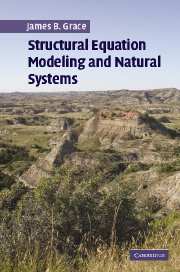Book contents
- Frontmatter
- Contents
- Preface
- Acknowledgments
- PART I A BEGINNING
- PART II BASIC PRINCIPLES OF STRUCTURAL EQUATION MODELING
- PART III ADVANCED TOPICS
- 6 Composite variables and their uses
- 7 Additional techniques for complex situations
- PART IV APPLICATIONS AND ILLUSTRATIONS
- PART V THE IMPLICATIONS OF STRUCTURAL EQUATION MODELING FOR THE STUDY OF NATURAL SYSTEMS
- Appendix I Example analyses
- References
- Index
7 - Additional techniques for complex situations
Published online by Cambridge University Press: 04 December 2009
- Frontmatter
- Contents
- Preface
- Acknowledgments
- PART I A BEGINNING
- PART II BASIC PRINCIPLES OF STRUCTURAL EQUATION MODELING
- PART III ADVANCED TOPICS
- 6 Composite variables and their uses
- 7 Additional techniques for complex situations
- PART IV APPLICATIONS AND ILLUSTRATIONS
- PART V THE IMPLICATIONS OF STRUCTURAL EQUATION MODELING FOR THE STUDY OF NATURAL SYSTEMS
- Appendix I Example analyses
- References
- Index
Summary
As mentioned earlier, the array of techniques associated with structural equation modeling has grown continuously since the LISREL synthesis. Some of this growth has been associated with refinements and some from new inventions. It is important for the reader to realize that the development of SEM methodology is still a work in progress. As described in Chapter 6, the ability to formulate and solve models containing composite variables, though long discussed, is only now being achieved. Refinements continue to be made in our ability to create models that are appropriate for the questions of interest and the data at hand. Structural equation modeling attempts to do something quite ambitious, to develop and evaluate multivariate models appropriate to almost any situation. Not surprisingly, the development of methods to accomplish this goal takes time and certain statistical limitations must be overcome.
For the most part, the material covered in Chapters 3, 4, and 50 represents basic principles relating to SEM. Many additional capabilities exist beyond those covered thus far, and many new developments are emerging. Some of these additional techniques and new developments are described in this chapter, although because this is such a vast subject, the treatments presented are only brief introductions to a select set of topics.
While the material in this chapter is in a section called Advanced topics, in my experience, the models that are most appropriate to understanding natural systems often require advanced elements or procedures.
Information
- Type
- Chapter
- Information
- Structural Equation Modeling and Natural Systems , pp. 181 - 204Publisher: Cambridge University PressPrint publication year: 2006
